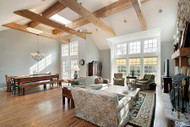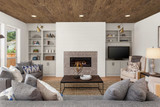
Ceiling beam spacing is all about personal preference, but there are some popular design constants that can help you achieve your desired look:
- Ceiling beams are typically spaced between two feet and eight feet apart.
- The most common ceiling beam spacing is four feet apart.
- Ceiling beam spacing is a matter of preference so there's no right or wrong answer!
Ceiling Beam Spacing: Everything You Need to Know
Ceiling beams add character and atmosphere to any room. Whether you're wanting to achieve a classic, modern, or rustic look, the addition of ceiling beams can bring out the best features of your home.
Ceiling beams come in a wide range of colors and finishes. Once you've settled on your preferred style, you'll need to turn your attention to the size and spacing of your ceiling beams.
How Far Apart Should Ceiling Beams Be?
Ceiling beam design includes two Driftwood Faux Wood Ceiling Beams in Antique Brown
There's no single answer to this question but it's possible to look at what the majority of homeowners, designers, and contractors do and then figure out what will work best for you. Ceiling beams also come in a range of sizes, and the size of your beams may impact the spacing you choose.
- The most common size for ceiling beams is six inches wide by six inches high.
- Many people with lower ceilings choose beams that are four inches high.
- The typical range for ceiling beam spacing is anywhere between two feet apart from one another up to eight feet apart.
- The most common ceiling beam spacing is four feet apart.
- Shorter spacing will give your ceiling an attractive patterned look, creating a real focal point.
- Wider spacing will make your beams look light and airy, almost as if they are structural, supporting the ceiling.
Ready to start your new home project?
Where Should Ceiling Beams Start on My Ceiling?
Rough Hewn Faux Wood Ceiling Beams in Rich Walnut
The next question is where to start your ceiling beams. You might not have given this much thought yet, so to help you get started, you can consider these two choices.
Placing Ceiling Beams Against Your Walls
Ceiling beam design includes seven Driftwood Faux Wood Ceiling Beams in Java
Place your first and last beams right up against the wall on each side of the ceiling to create a tidy, enclosed effect. Note that when a beam butts up against a wall, only two sides are visible – so you can save money by ordering L-headers that match your other beams.
Another option is to use half-width L-headers to make it look as if half of the beam is embedded in the wall, like a true timber-framed house.
Placing Ceiling Beams Away From Your Walls
Ceiling beam design includes three Driftwood Faux Wood Ceiling Beams in Latte
Place your first and last beams some distance away from your walls to create a more expansive look. You can make the spacing equal between the walls and each one of your beams—or have a shorter distance between the walls and your first and last beams.
Notable Ceiling Beam Design Trends
The best thing about ceiling beams is their versatility. Their styles and placements offer endless design possibilities. They can help a room appear vintage, exuding an old-world style, or ultra-modern, with a chic contemporary feel. Here are a few ceiling beam design trends to keep in mind as you decide on your ideal ceiling beam spacing.
Exposed Ceiling Beams
It used to be that folks wanted to cover up all the fixtures and fittings so a ceiling looked like one smooth plane. But for many, that ceiling style ship has sailed. Nowadays, people like to show how things work—at an architectural level.
So whether you're uncovering existing beams or installing new ceiling beams, your exposed ceiling beams will fit right in with current-day trends!
Coffered Ceilings
A coffered ceiling is when you place wooden beams and other decorative features in such a way that they form an even grid across your entire ceiling.
The classic version of coffered ceilings often featured white-painted beams on a white ceiling, or perhaps some subdued creams and grays. But you could use natural wood beams and bold colors on your ceiling to achieve a very modern look.
Ceiling Trusses
If you have any vaulted ceilings, the supportive ceiling trusses may or may not be highly visible. Some people prefer to hide the trusses or paint them in the same color as the ceiling so they are unobtrusive.
But why not turn your ceiling trusses into a design statement? Just add real wood or faux wood beams to enhance the height and lines of your ceiling.
Wood Corbels
To make your ceiling beams pop, consider adding decorative wood corbels to connect your beams to your walls with a flourish. Corbels are available in many different styles and colors so you can easily match them to other patterns and designs found in your home.
Floating Mantel
Once you've installed your ceiling beams, you might want to come up with ways to tie the beams in with the rest of your room. A floating mantel can turn your fireplace or a key piece of furniture into a beautiful and practical focal point.
For best results, order a mantel that matches the texture and color of your ceiling beams.
Wood Ceiling Beams vs. Faux Wood Ceiling Beams
Like everything these days, ceiling beams are available in a range of both traditional and contemporary materials. Solid wood beams may look nice but will cost more and need more effort to install. It might help to base your decision on whether you have a new or old home.
Historic Homes
If you have a historic home, the best practice is to use the same kind of solid wood as other features in your home. If the original type of wood is no longer available, you could at least try to find materials with a similar color and grain.
Modern Homes
In a modern home, you have no restrictions and you might like to explore box beams, which are hollow and can be made of wood or faux wood. Box ceiling beams have several advantages over solid wood beams.
- Box ceiling beams are lighter so they cost less to buy and ship.
- Because they're lightweight and hollow, they're much easier to install.
- You can choose from a wide variety of colors and grains.
- You can use box beams to run wires and cords for your lighting and sound systems around your home for a streamlined look.
Ready to Select the Best Ceiling Beams for Your Home?
Ceiling beam design includes five Driftwood Faux Wood Ceiling Beams in Early American
Hyperrealistic and affordable, faux wood ceiling beams provide amazing value for your money. Plus, they’re easy to install and can add instant charm and personality to your favorite rooms.
And for projects that don’t need structural support, wood ceiling box beams provide the attractive authenticity of real wood at a lower price than solid wood beams.
Whichever ceiling beam type suits your design sensibilities and budget, you’ll have a diverse array of styles, colors, and finishes to choose from when you order your handcrafted beams from Barron Designs.
Ready to beautify your space with stunning ceiling beams?
Shop Related Products






